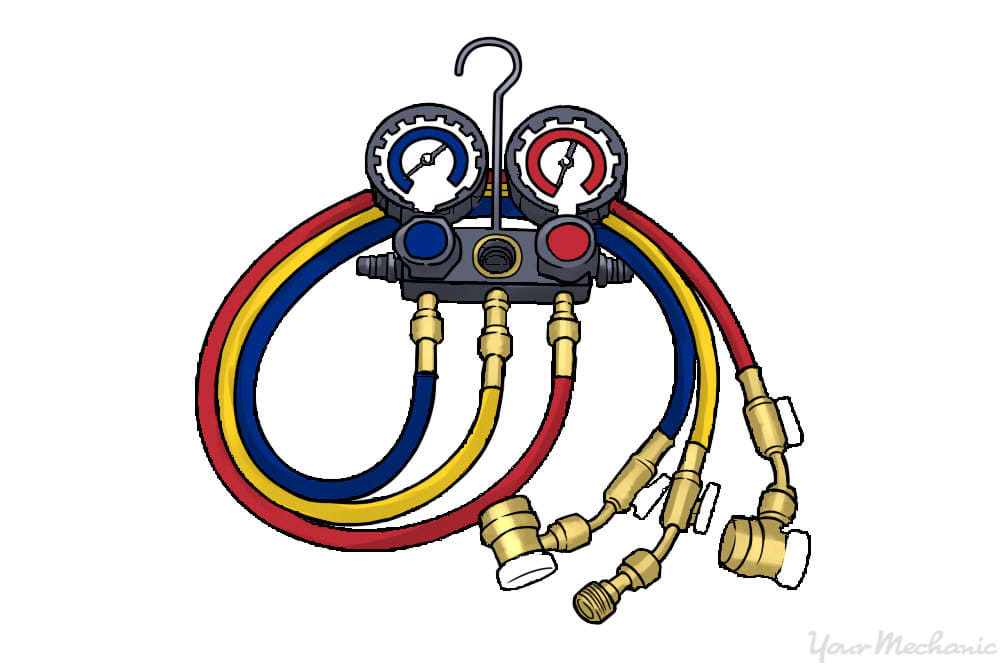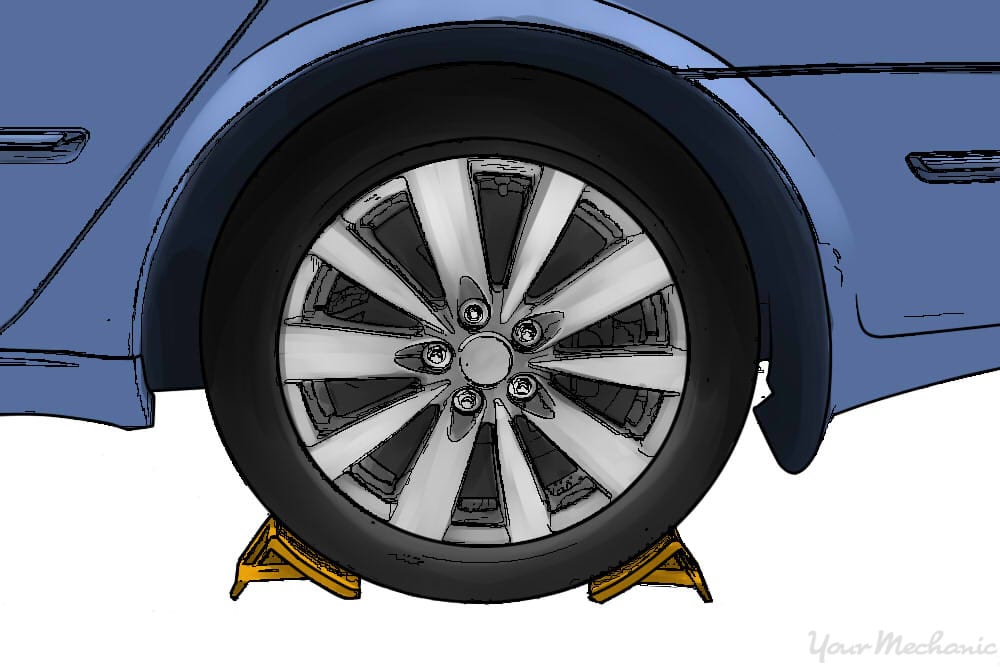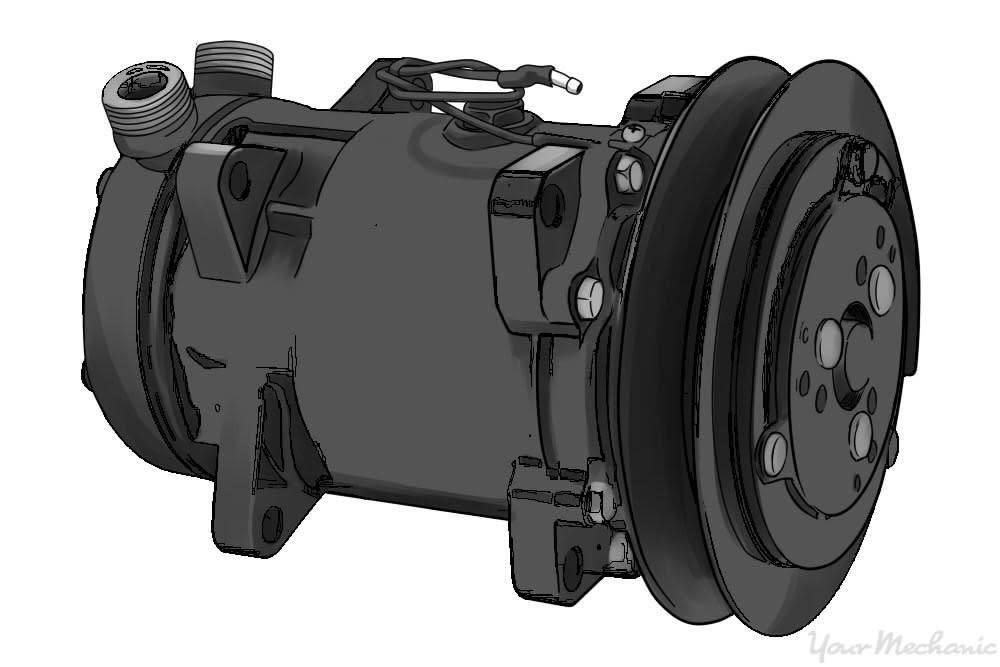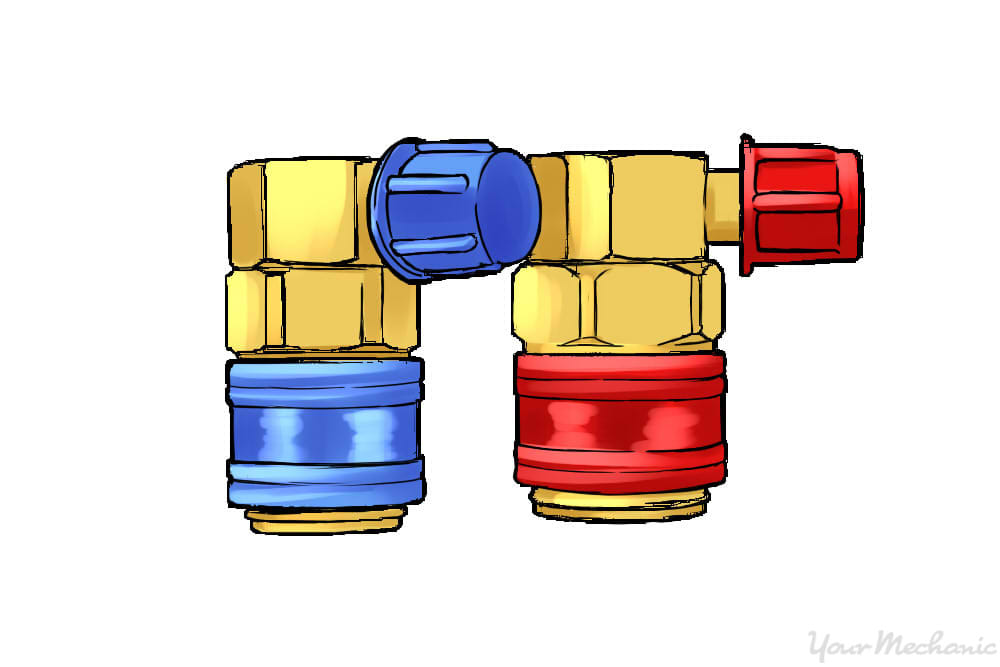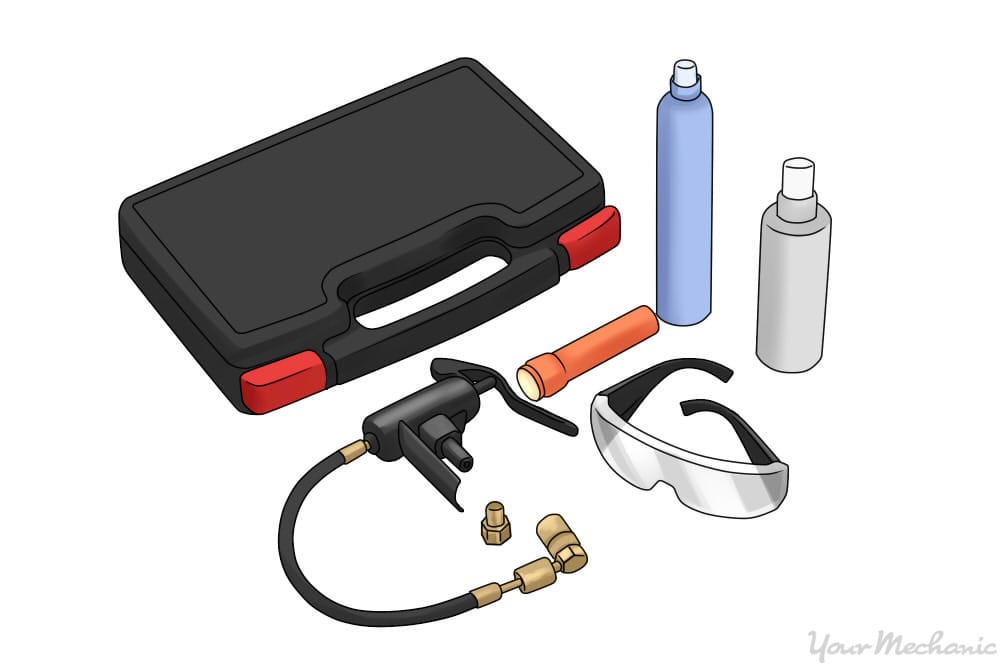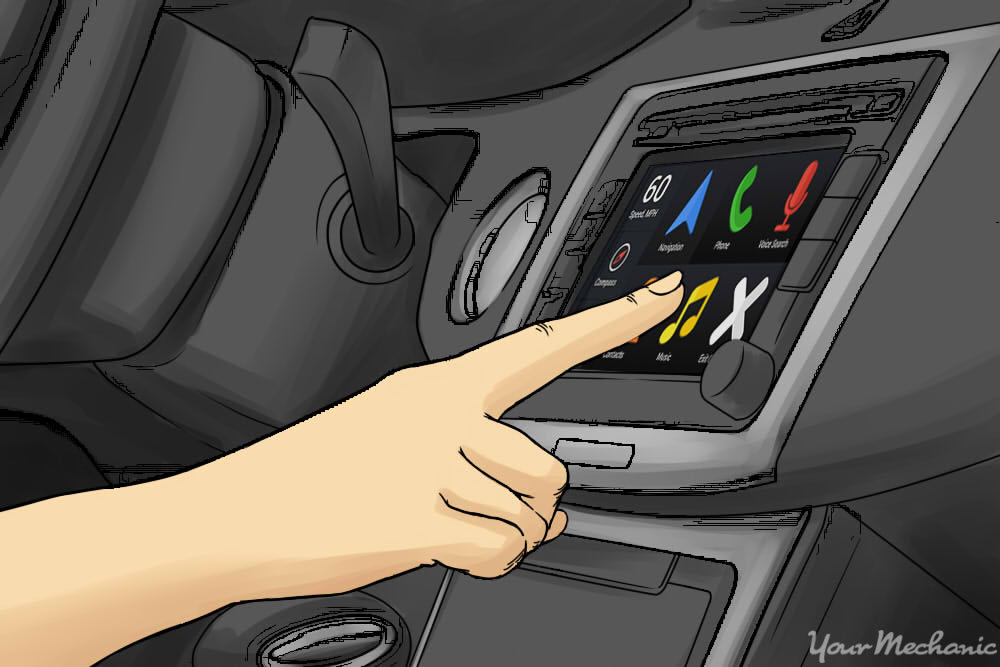

There is never a good time for your air conditioning in your car to stop working, but it typically seems to happen in the dead heat of summer. If your AC system has either quit working or has stopped working well, you're faced with driving your vehicle around with the windows down - which brings little relief when it is hot outside. Having some knowledge about how the air conditioning works in your vehicle can help you get the system functioning again.
Part 1 of 9: Understanding the AC system and components
Your car's air conditioning system works just like a refrigerator or your home air conditioning. The purpose of the system is to remove hot air from the inside of your vehicle. It consists of the following components:
Component 1: Compressor. The purpose of the compressor is to pressurize the air conditioning system and circulate the refrigerant. It's located at the front of the engine and is typically driven by the main drive belt.
Component 2: Condenser. The condenser is located in the front of the radiator and is used to remove heat from the refrigerant.
Component 3: Evaporator. The evaporator is located inside the dash of the vehicle and is used to absorb heat from the interior of the car.
Component 4: Metering device. This is known as a metering tube or an expansion valve and can be located either under the dash or under the hood near the fire wall. Its purpose is to change the pressure in the air conditioning system from high pressure to low pressure.
Component 5: Hoses or lines. These consist of metal and rubber lines to carry the refrigerant.
Component 6: Refrigerant. Typically, all systems today contain R-134A refrigerant. This can be purchased over the counter at most auto parts stores. Older vehicles were built with R-12, which is no longer used because it contained high amounts of ozone depleting compounds. If you have a license and certification you can still purchase this, though most people opt to retrofit this system to the newer R-134A refrigerant.
Though these are the primary components of the air conditioning system, your vehicle has a series of electrical circuits that allow it to function, as well as a dash system that contains numerous doors that move within the dash that can affect effectiveness. Below are the most common causes of poor air conditioning performance and what can be done to get you comfortably back on the road.
Part 2 of 9: Tools and safety
When performing any air conditioning system service you must have the proper tools - and exercise caution when using them.
Reason 1: High pressure. The air conditioning system is filled with high pressure refrigerant, and can operate at over 200 psi, which can be very dangerous.
Reason 2: High temperature. Parts of the AC system can reach well over 150 degrees Fahrenheit so be very careful when coming in contact with parts of the system.
Reason 3: Moving parts. You must watch out for moving parts under the hood while the engine is running. Keep all articles of clothing tightly secured.
Materials Needed
- Air conditioning manifold gauge set
- Gloves
- Refrigerant
- Safety Glasses
Warning: Never add anything but the recommended refrigerant to the AC system.
Warning: Always wear safety glasses when servicing any pressurized system.
Warning: Never install the gauges with the system running.
Part 3 of 9: Performance check
Step 1: Park your vehicle on a level surface.
Step 2: Place the wheel chocks around the driver side rear tire.
Step 3: Open the hood.
Step 4: Locate the air conditioning compressor.
-
Tip: The compressor will be mounted towards the front of the engine and is driven by the engine drive belt. You may need a flashlight to be able to see it. It's one of the larger pulleys in the system and has a separate clutch located on the front of the compressor. It will also have two lines connected to it. If you have trouble locating it then start your engine and turn the air conditioning off. The compressor pulley will be spinning with the belt, but you should notice that the front of the compressor clutch is stationary.
Step 5: Turn on the AC. Turn the air conditioning on in the vehicle and see if that clutch that was previously stationary is now engaged.
Step 6: Turn the fan to Medium. If the compressor clutch engaged, return to the inside of your vehicle and turn the fan speed to Medium.
Step 7: Check the air temperature. See if the temperature of the air coming from the main dash vents is cold.
Read the parts below to understand the different conditions that you may see:
- No air coming out of the vents
- The compressor clutch not engaging
- The clutch is engaging but the air not cold
- The system is empty on refrigerant
- The system is low on refrigerant
Part 4 of 9: No air comes out of the dash vents
When performing your initial check, if air does not come from the center dash vents or if the air is coming from the wrong vents (such as the floor or windshield vents) then you have a problem with the interior climate control system.
- Airflow problems can be caused by anything from a blower motor problem to an electrical issue or a module failure. This would need to be diagnosed separately.
Part 5 of 9: The compressor clutch does not engage
The clutch may not engage for several reasons, the most common being low refrigerant in the system, but it may also be an electrical issue.
Reason 1: Voltage. Voltage is not sent to the clutch when the air conditioning is turned on due to an open circuit in the electrical circuit.
Reason 2: Pressure switch. An air conditioning system pressure switch can disrupt the circuit if certain pressures are not met or if the switch is failing.
Reason 3: Input issue. More up to date systems are computer controlled and use numerous other inputs including vehicle interior and exterior temperature to determine whether or not to turn the compressor on.
You need to determine if there is refrigerant in the system.
Step 1: Turn the engine off.
Step 2: Install the gauges. Install the gauge set by locating the high and low side quick connections.
-
Tip: The location of these vary on every car, but most of the time you will find the low side on the passenger side of the engine compartment and the high side towards the front. The size of the fittings are different so you will not be able to install the gauge set backwards.
Step 3: Observe the pressure readings on the gauges.
Warning: Do not check for pressure by pressing on the fitting to see if refrigerant comes out. This is dangerous and it is illegal to vent refrigerant into the atmosphere.
If the reading is zero you have a major leak.
If there is pressure but the reading is below 50 psi then the system is low and may just need to be recharged.
If the reading is above 50 psi and the compressor is not engaging then there is either a problem with the compressor or you have an electrical system failure that needs to be diagnosed.
Part 6 of 9: The clutch engages but the air is not cold
Step 1: Turn the engine off and install the gauge set.
Step 2: Restart the engine and turn on the air conditioning.
Step 3: Observe the pressure readings.
Though every air conditioning system will vary, you want to see the high side pressure around 20 psi and the low side around 40 psi.
If both the high and the low side are below these readings then you may need to add refrigerant.
If the readings are very high then you may have a problem with air trapped in the system or an airflow problem with the condenser.
If the pressures do not change at all when the compressor engages then the compressor has failed or there is a problem with the metering device.
Part 7 of 9: The system is empty
Materials Needed
If there was not pressure found during your test then the system is empty and there is a leak.
- Most air conditioning system leaks are small and difficult to find.
The most effective way to locate a leak is with refrigerant dye. Dye kits are sold at most auto parts stores.
Using the manufacturer's instructions, inject the dye into the air conditioning system. This is usually done through the low pressure service port.
Allow the dye to works its way through the system.
Using the supplied UV light and glasses you will inspect all of the components and hoses of the air conditioning system and look for any glowing material.
Most dyes are either orange or yellow.
Once you find the leak repair it as needed.
If the system was empty then it will need to be fully evacuated and recharged.
Part 8 of 9: The system is low
When adding refrigerant to the system you want to take it slow as you do not know how much it actually needs.
When a shop performs this duty, they use a machine that pulls the refrigerant from the system, weighs it, and then allows the technician to add the exact amount of refrigerant back into the system.
Most store-bought refrigerant kits come with their own charging hose and gauge that allow you to add refrigerant yourself.
Step 1: Turn off the engine.
Step 2: Disconnect low side gauge. Disconnect the gauge set from the low side port.
- Tip: You must only charge on the low side to prevent injury.
Step 3: Install charge kit. Install the charging kit to the low side connection on the AC system.
Step 4: Turn on engine. Turn on the engine and the air conditioning.
Step 5: Observe. Observe the gauge on the kit and begin adding the refrigerant whether it be with a button or a trigger on the kit.
- Tip: Add the refrigerant in small amounts, checking the recharge gauge between applications.
Step 6: Reach desired pressure. Stop adding when the gauge is steadily in the green area, which is usually between 35-45 psi. Allow the system to continue running and check the temperature of the air coming out of the dash vents making sure it is cold.
Step 7: Disconnect the charging hose.
You have now filled the system with refrigerant. Make sure that you do not overcharge the system as too much refrigerant is just as bad - if not worse - than too little.
Part 9 of 9: The air conditioning still does not work
If the air conditioning still does not work as desired further testing is needed.
Warning: You must have a special license to legally service an air conditioning system.
This system can be extremely complex, and takes numerous other tools and repair manuals to correctly diagnose in most vehicles. If performing these steps did not achieve cold air from your vents or you are not comfortable with doing this work, you need to enlist the help of a certified mechanic who has the tools and the knowledge to test your air conditioning system.



